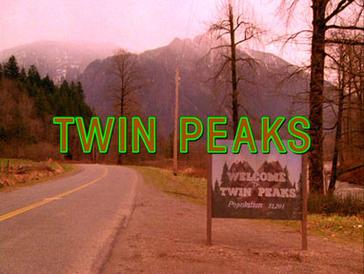 We started the session by watching part of an episode of the American tv-series 'Twin Peaks'. 'Twin Peaks' was created for ABC network by film director David Lynch and TV-crime genre writer Mark Frost and was regarded by critics as one of the most influential mainstream network programmes of modern TV era. The series has two seasons (1990-1991) and sequel series is set to return in may 2017 as 18 1-hour episodes.
We started the session by watching part of an episode of the American tv-series 'Twin Peaks'. 'Twin Peaks' was created for ABC network by film director David Lynch and TV-crime genre writer Mark Frost and was regarded by critics as one of the most influential mainstream network programmes of modern TV era. The series has two seasons (1990-1991) and sequel series is set to return in may 2017 as 18 1-hour episodes. Later we discussed how we can define experimental vs conventional, whether there are different types of experimentation in different genres of television, and what modes of critical analysis we can use to define 'experimental'.
How can we define experimental?
- Challenges and/or subverts genre codes and conventions
- Innovations in stylistic presentation (mise en scene, editing, etc)
- Innovations in narrative (how the story is told: structure and time)
Conventional
- Linear narrative
- Episodic series or continuous serial
- Genre-specific codes and conventions (crime, sci-fi, medical, etc)
- Formal 'Hollywood' style (mise en scene, continuity, editing, etc)
- Classic stereotypical or archetypical characters
Experimental
- Non-linear or fractured narrative
- Hybrid format
- Hybrid or multi-genre
- Innovative or unusual visual- and audio techniques (e.g breaking the 4th wall)
- Unconventional characters, or do not relate to specific genre expectations of behaviour
Conventional narrative formats
Episodic series - usually long running (13 or more episodes), primetime, self-contained storylines and closed resolution within each show (e.g crime procedurals like CSI or sci-fi shows like Dr Who)
Continuous serial (soap opera) - traditionally daytime, open-ended storylines with cliffhangers.
Episodic serial (miniseries) - short-run drama (more than 6 hours in two or more parts) which combined the closed resolution of the episodic series with the ongoing multi-arc strands of the soap opera (e.g, roots)
Sequential series (Hill Street Blues, Miami Vice) - development of the episodic series format which runs narrative arcs throughout the series and end season with cliffhangers.
Twin Peaks narrative format
- Episodically threaded narrative and cliffhangers finale of the sequential series (co-creator Mark Frost worked on pioneering police drama series, Hill Street Blues)
- Open-ended multi-character/multi-plotlines of the continuous serial or soap opera
Genre hybridity
Crime genre
- Episodic
- Forensic rationality
- Central detective character
- Crime resolution and narrative closure
Soap Genre
- Continuing
- Emotional melodrama
- Multiple character arcs
- Crime may take weeks, months or years to be resolved
Supernatural / Horror Genre
- Demonic possesion
- Native American folklore
Postmodernism
- Ideologically disruptive
- Deconstructs form, often in playful way
- May use elements of high and low culture (usually through homage or pastiche)
- Meta-references or self-reflexivity (intersexuality, self-referentiality)
- Pacific North-West smalltown setting (rather than conventional crime genre urban city locations)
- Costumes, makeup and set design evoke 1950s (though se
ries set in contemporary timeframe)
ries set in contemporary timeframe)
- Unconventional lighting and staging (flickering neon in autopsy room, objects framed in long close-ups for dramatic effect)
- Scenes filmed in wide and/or long shots (rather than conventional close-ups and shot-reverse shots of most television drama)
- Action held longer in the frame than usual (either for comic effect (dialogue scenes in police station) or exaggerated emotional resonance (crying scenes))
- Heavy use of both original soundtrack music and surreal ambient sounds (Lynch's signature industrial hum)
- Music is used for heightened emotional effect (rather than just b
ackground underscore or action cues as in most TV drama)
ackground underscore or action cues as in most TV drama)
- Use of diegetic and non-diegetic leitmotifs associated with specific characters (Audrey's jazzy dance theme and Laura Palmer's melancholy theme)
Extra-diegetic dramatic elements
- The Red Room - extra-dimensional location first seen in Agent Cooper's dream.
- BOB - demonic entity
- 'Invitation to love' - fake soap opera seen briefly in every episode of the first season (Meta commentary on Twin Peaks itself)
Acting and character
- Twin Peaks features many conventional dramatic archetypes: the analytical crime investigator, the upright sheriff, the corrupt businessman.
- Characters are written and acted in a highly stylised or quirky manner that defy genre convention and challenges audience's preconceptions
Influence on other TV dramas
Northern Exposure - quirky fish-out-of-water comedy-drama using same Pacific North West setting
The X Files - FBI agents investigating the supernatural
Lost and fringe - surreal sci-fi and supernatural elements; fractured timelines (Fringe contains specific references to Twin Peaks)
The Sopranos - Tony Soprano dream sequences
The Killing (US remake) - teen murder-noir in Pacific North West
Conclusion
- Experimentation and innovation require challenging and changing conventional modes of production and presentation
- What was once considered experimental can become conventional as new ideas are copied and become more familiar to audiences
- In analysing any experimental programme, we should ask: what were the filmmaker's intentions? And does the programme or film benefit from any prior legacy of innovation that provides a historical context in which it can be placed
//All images from Google.com\\


No comments:
Post a Comment